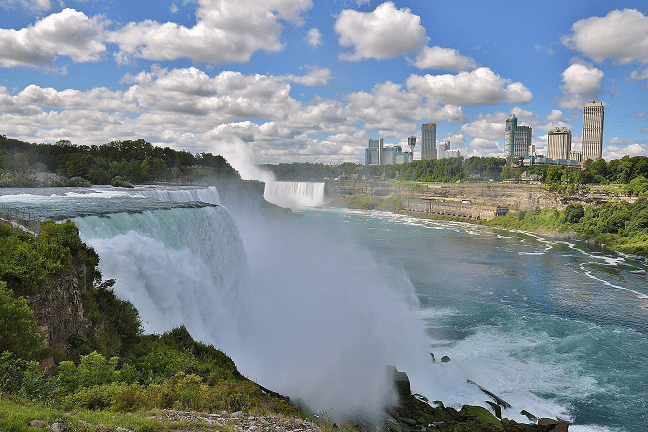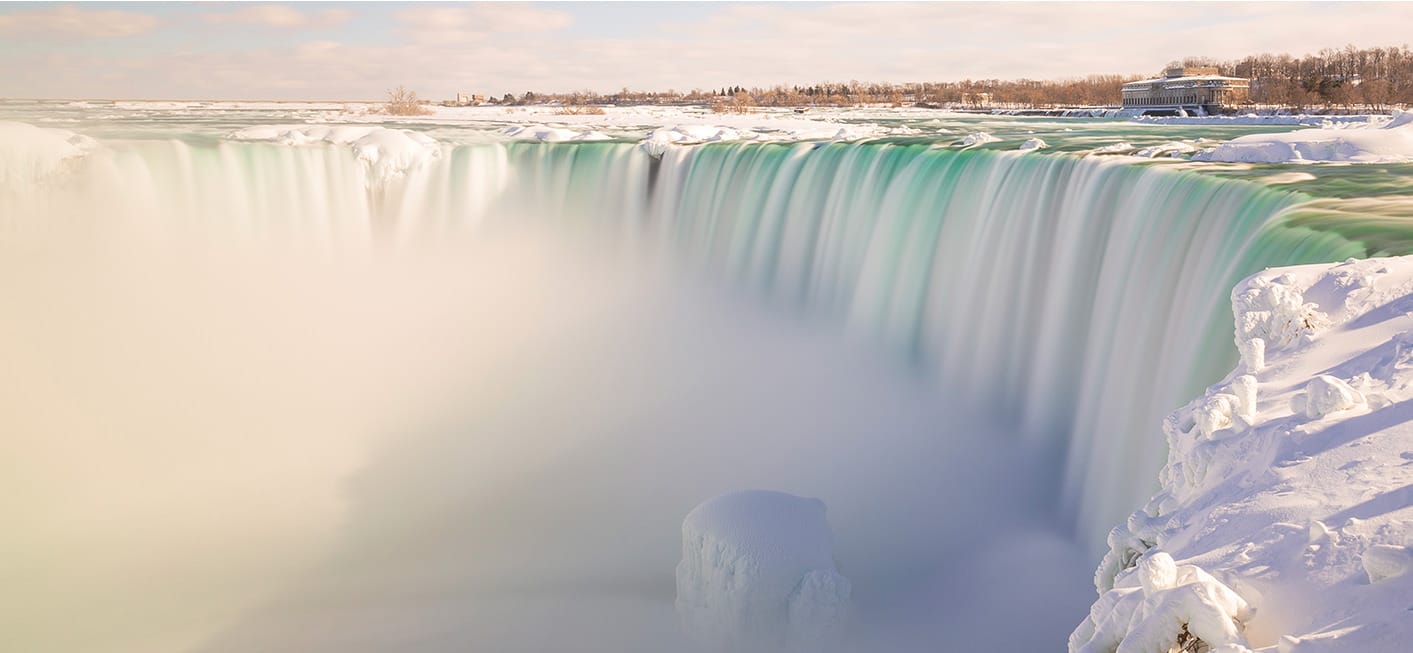When you see Niagara Falls, it’s a seemingly never-ending rush of water that drops off the brink over and over again. In truth, the Falls have stopped twice in history; once of natural causes, and the other for maintenance work on the rocky shoal. Aside from those two examples, the waterfalls never stop flowing, roaring through the area and soaking visitors down below on the iconic Niagara Falls boat tours. More than 6 million cubic feet or 168,000 cubic metres of water go over the Horseshoe Falls alone every minute, water speeds reaching up to 109 km/h or 68 mph.
But where does all this water come from? Learn fun facts about Niagara Falls, including how they keep flowing, here.
How Does Niagara Falls Work?
Niagara Falls is made up of three separate waterfalls: the American Falls, the Bridal Veil Falls and the Horseshoe Falls, which is the largest waterfall. The waterfalls have been pumping out water for the past 12,000 years, even as they’ve receded about 7 miles back.
The water rushing over the Niagara Falls waterfalls comes from the Great Lakes, which is the world’s largest surface freshwater system in the world. It contains about 18% of the world’s freshwater supply, with water flowing into the Great Lakes from streams and rivers that empty into it.
The rivers and streams empty into Lake Michigan, Lake Erie, Lake Superior, Lake Huron and Lake St. Clair, all in North America connecting the U.S. and Canadian borders. Precipitation and groundwater replenish the Great Lakes. Less than 1% of water in the Great Lakes is renewable, while the rest comes from the last ice age. It’s also known as “fossil” water.
As water empties into the Great Lakes, it travels from Lake Superior through Niagara along the Niagara River. Once the water reaches the Niagara River, it passes over the waterfalls. After reaching the waterfalls, it flows north into the final Great Lake, Lake Ontario.
From there, the water goes into the St. Lawrence River and then the Atlantic Ocean. From Lake Michigan to the Atlantic Ocean, the water flow journey takes at least 15 hours.
During high- or low-precipitation years, the Great Lakes water flow can be greatly affected. The International Joint Commission, made up of the U.S. and Canada, has regulated water flow levels since 1910. In 1950, a treaty between the U.S. and Canada was created to determine the diversion of water from the Niagara Falls for power generation. Other water is used for navigation, Niagara Falls flow and domestic and sanitary purposes.
 What Gives the Water Odd Colours?
What Gives the Water Odd Colours?
You might notice brown foam below Niagara Falls or a greenish tint to the Niagara River. The water is still fresh water and is perfectly safe. The colours come from natural elements the rushing waters pick up along their journey.
The brown foam below the Niagara Falls waterfalls is that colour because of clay. Clay contains decayed vegetative matter, which is absorbed as the water travels. It mostly comes from Lake Erie’s shallow eastern basin.
As for the river, you’ll notice it’s a vibrant green colour. That brilliant hue comes from minerals. There are an estimated 60 tons of dissolved minerals that flow over Niagara Falls every minute. The minerals consist of “rock flour,” which is finely ground rock, as well as dissolved salts. The rock flour primarily comes from the limestone bed, as well as sandstones and shales from under the Niagara Falls limestone cap.
What Is the Future of Niagara Falls?
Since Niagara Falls has already moved back, you may be wondering if the waters will keep running forever. Not to worry: Niagara Falls still has at least around 20,000 years to be in production. Wind and rain do contribute to Niagara Falls erosion, which is why it’s expected to disappear into Lake Erie some time in the very distant future.
For now, flow control and hydro-power generation diversion help to slow down erosion. With flow control, erosion may be able to be reduced to just 1 foot every 10 years. The limestone cap rock is another natural factor slowing down Niagara Falls erosion, since the material is resistant to erosion.
Another possible outcome to the future of Niagara Falls is evaporation. Scientists speculate that around 2,000 years from now, the American Falls waterfalls could dry up. If that happens, it would take on the same appearance as the Niagara Glen.
See Niagara Falls in Full Force Now
If you want to see Niagara Falls in its full glory, the best time is now. The water rushes over with tremendous force, and you can get soaked yourself with a visit to the waterfalls on the Hornblower Niagara Cruises. Book your Niagara Falls trip today.


 What Gives the Water Odd Colours?
What Gives the Water Odd Colours?